Deep in the cosmos lies a fascinating celestial wonder known as the Horsehead Nebula, a mesmerizing icon of dark nebulas. Its enigmatic shape and mysterious nature have captured the curiosity of astronomers and stargazers alike. This article will take you on a captivating journey to discover the secrets of the Horsehead Nebula, from understanding its formation to locating it in the vast night sky. We will explore the intricate features of this stellar phenomenon, delve into its significance in scientific research, and unveil the breathtaking beauty of the nebula through mesmerizing astrophotography and artistic representations. Get ready to embark on an extraordinary exploration that will leave you in awe of the wonders of the universe.
Contents
- The Horsehead Nebula: A Stellar Phenomenon
- Locating the Horsehead Nebula
- Exploring the Nebula’s Features
- Horsehead Nebula and Scientific Research
- Unveiling the Beauty of the Horsehead Nebula
- Conclusion
-
Frequently Asked Questions
- What is a nebula?
- How was the Horsehead Nebula formed?
- Why is the Horsehead Nebula so dark?
- Can the Horsehead Nebula be seen with the naked eye?
- Is the Horsehead Nebula part of the Zodiac constellations?
- How large is the Horsehead Nebula?
- What is the significance of studying the Horsehead Nebula?
- How can I locate the Horsehead Nebula in the night sky?
- Can the Horsehead Nebula be photographed?
- Has the Horsehead Nebula been featured in mythology or art?
- References
-
Frequently Asked Questions
- 1. How was the Horsehead Nebula discovered?
- 2. What gives the Horsehead Nebula its unique shape?
- 3. Can the Horsehead Nebula be seen with the naked eye?
- 4. How far away is the Horsehead Nebula?
- 5. What is the significance of the Horsehead Nebula in scientific research?
- 6. How can the Horsehead Nebula be located in the night sky?
- 7. What equipment and techniques are required to observe the Horsehead Nebula?
- 8. How does studying the Horsehead Nebula contribute to our understanding of star formation?
- 9. Can the Horsehead Nebula be captured in astrophotography?
- 10. Are there any artistic representations of the Horsehead Nebula?
- References
- Read More
The Horsehead Nebula: A Stellar Phenomenon
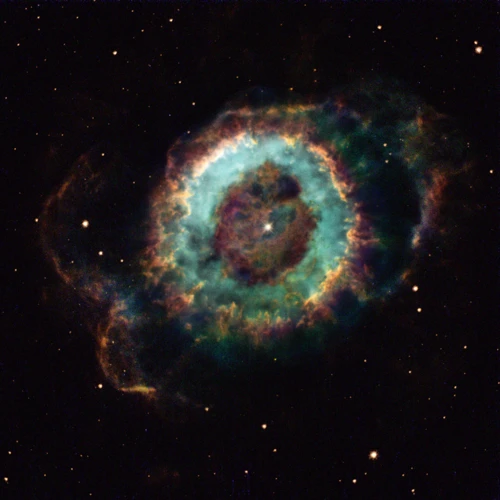
The Horsehead Nebula, also known as Barnard 33, is an extraordinary stellar phenomenon that captivates astronomers and space enthusiasts around the world. This dark nebula is located in the Orion Molecular Cloud Complex, approximately 1,500 light-years away from Earth. Its distinct shape has made it an icon of the night sky, resembling a horse’s head emerging from a cloud of gas and dust. The Horsehead Nebula is a region of dense, dark interstellar dust, mostly composed of hydrogen gas and small amounts of other elements. This dust obscures the light from the background stars, creating the unique silhouette that we see. One interesting fact about the Horsehead Nebula is that it is not actually emitting light of its own; instead, it is reflecting the light of nearby stars that illuminate the surrounding gas. This makes the nebula visible in certain wavelengths of light. Its elusive nature adds to the allure and mystique surrounding this cosmic wonder. Studying the Horsehead Nebula provides valuable insights into the process of star formation and the complex interactions between materials in the interstellar medium. This enigmatic beauty serves as a reminder of the vastness and complexity of the universe we live in, and continues to inspire astronomers and artists alike to explore and depict its mesmerizing features.
The Enigmatic Horsehead Shape
The enigmatic shape of the Horsehead Nebula is one of the most recognizable features in our night sky. This iconic silhouette, resembling the head of a horse emerging from the depths of space, is a result of intricate interactions between dust and gas. The distinct shape is created by a dark cloud of dust that absorbs the light from the background stars, resulting in a stark contrast against the glowing gas surrounding it. The dark cloud is composed mainly of hydrogen gas and dust particles, which scatter and block the light, revealing the shape against the backdrop of brighter emission nebulae. While the cause of the specific shape is still a subject of scientific discussion, it is believed that the intricate structure arises from a combination of factors, including the density and distribution of the dust, as well as the influence of nearby stars and magnetic fields. The intriguing form of the Horsehead Nebula has inspired countless artists and stargazers, and it continues to ignite our curiosity about the mysteries of the cosmos.
An Iconic Dark Nebula
The Horsehead Nebula is truly an iconic dark nebula that has become synonymous with the grandeur and mystery of the cosmos. Dark nebulae are vast regions of space filled with dense interstellar dust and gas, which block the light from background stars and create stunning silhouettes against the backdrop of the universe. They are often regions where new stars are born, as the gravitational collapse of the gas and dust leads to the formation of protostars. What sets the Horsehead Nebula apart is its incredible shape, resembling a horse’s head emerging from the darkness. This distinctive silhouette has made it instantly recognizable and has earned it a place in popular culture. It has become a symbol of the immensity and beauty of the cosmos, capturing the imagination of people around the world. From ancient mythology to modern astronomy, the Horsehead Nebula continues to inspire wonder and awe. Whether you are a seasoned astronomer or an avid stargazer, observing the enigmatic form of this iconic dark nebula is an experience that will leave you in awe of the vastness and complexity of our universe.
Formation of Nebulas
The formation of nebulae is a complex and fascinating process that occurs within the vastness of the universe. Nebulas are created from vast clouds of gas and dust that exist between stars. These clouds, known as molecular clouds, are composed mostly of hydrogen and helium, along with trace amounts of other elements. The formation process begins when disturbances, such as shockwaves from supernovae or the gravitational pull of denser regions, cause the cloud to collapse under its own gravity. As the cloud contracts, it starts to spin, forming a rotating disk with a dense core at its center. This core, known as a protostar, continues to gather mass from the surrounding gas and dust, gradually increasing in temperature and density. Eventually, the core becomes hot and dense enough to ignite nuclear fusion, giving birth to a new star. The remaining material in the surrounding disk is dispersed outward, forming a glowing shell of gas and dust known as a planetary nebula or a reflection nebula, depending on the source of illumination. These spectacular formations provide a fertile ground for the formation of planets and other celestial objects. The study of nebulae and their formation mechanisms contributes to our understanding of the birth, life, and death of stars throughout the cosmos. The Horsehead Nebula, with its unique shape and composition, offers valuable insights into this captivating process and continues to intrigue astronomers as they unravel the secrets of the universe.
Significance of the Horsehead Nebula
The Horsehead Nebula holds significant importance in the field of astronomy and astrophysics. It serves as a crucial site for studying and understanding the process of star formation. The dense clouds of gas and dust within the nebula provide a fertile environment for the birth of new stars. By observing the intricate details of the Horsehead Nebula, scientists can gain insights into the complex dynamics of these regions, such as the gravitational collapse of molecular clouds and the formation of protostellar cores. The Horsehead Nebula’s iconic shape and distinct features have also made it a popular subject for astrophotography and artistic representations, allowing the general public to appreciate the beauty and wonders of the cosmos. Additionally, studying dark nebulae like the Horsehead Nebula contributes to our understanding of the interstellar medium and its role in the evolution of galaxies. It sheds light on the distribution and composition of gas and dust in space, providing valuable information for cosmological research. The Horsehead Nebula has become a symbol of the awe-inspiring diversity of celestial objects and their significance in unraveling the mysteries of the universe.
Locating the Horsehead Nebula
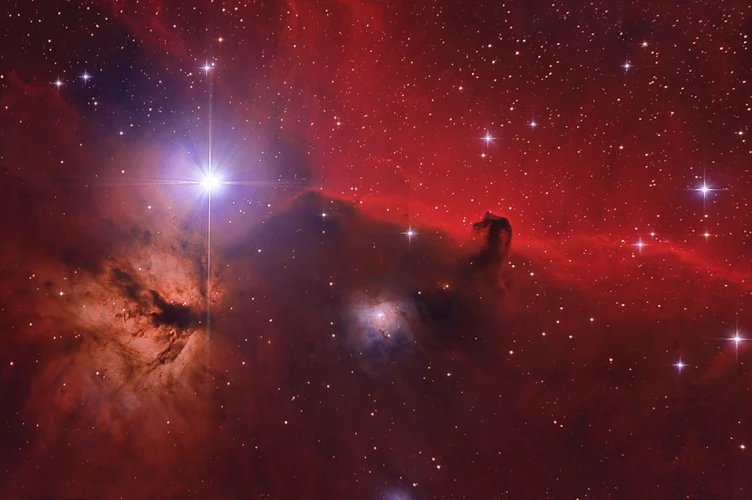
Locating the Horsehead Nebula in the vast expanse of the night sky requires a bit of knowledge and the right tools. To begin your quest, head towards the constellation of Orion, a prominent and easily recognizable constellation. Look for the three bright stars that form Orion’s Belt, and then shift your gaze slightly downward. The Horsehead Nebula lies just below the easternmost star of Orion’s Belt, also known as Alnitak. While the nebula itself is invisible to the naked eye due to its dark nature, with the aid of a telescope, you can observe its silhouette against the backdrop of glowing hydrogen gas. It is important to note that locating the Horsehead Nebula is no easy feat, as it demands dark and clear skies, free from light pollution. Experienced astronomers often use star charts or smartphone apps to assist in pinpointing its exact position. Additionally, using narrowband filters that isolate specific wavelengths of light, such as hydrogen-alpha or sulfur filters, can enhance the visibility of the nebula and improve the viewing experience. Armed with these tools and knowledge, you’re equipped to set off on your celestial journey and witness the allure of the Horsehead Nebula firsthand.
Observing the Nebula
Observing the Horsehead Nebula is a captivating experience for both amateur and professional astronomers. Due to its location in the Orion constellation, it is most visible in the northern hemisphere during the winter months. To observe the nebula, it is essential to have a telescope with a large aperture, which allows for greater light-gathering capability and detail. A telescope with a focal length of at least 1000mm is recommended to bring out the intricate features of the Horsehead Nebula. Additionally, using filters such as a hydrogen-alpha filter can enhance the visibility of the nebula by isolating the specific wavelength of light emitted by hydrogen gas. Dark sky conditions away from city lights are crucial for optimal viewing, as light pollution can hinder the visibility of faint objects like the Horsehead Nebula. After locating the constellation of Orion, one can find the Horsehead Nebula just below the star Alnitak, which forms the easternmost star in Orion’s Belt. It typically appears as a dark notch against the bright background of the surrounding emission nebula. Patience is key when observing the Horsehead Nebula, as it may take some time for your eyes to adapt to the low-light conditions and to discern the intricate details. So grab your telescope, find a dark spot under the night sky, and be prepared to be awe-struck by the exquisite beauty of the Horsehead Nebula.
Position in the Night Sky
The Horsehead Nebula occupies a prominent position in the night sky, making it a sought-after target for astronomers and astrophotographers. Located in the constellation of Orion, the nebula can be found just below the belt of the iconic Orion constellation. Specifically, it is situated in the southern region of the well-known Orion’s Belt, which consists of three bright stars: Alnitak, Alnilam, and Mintaka. To locate the Horsehead Nebula, one can use the middle star in Orion’s Belt, Alnilam, as a reference point. From there, move downward towards the horizon until the distinctive shape of the Horsehead Nebula comes into view. Due to its position in the sky, the best time to observe or photograph the nebula is during the winter months in the Northern Hemisphere. It is important to note that the Horsehead Nebula is relatively dim, so observing it requires dark and clear skies, away from light pollution. Additionally, using a telescope with moderate to high magnification can help reveal more details of this captivating stellar phenomenon. The strategic location of the Horsehead Nebula in the night sky offers astronomers and enthusiasts the opportunity to marvel at its unique features and delve into the mysteries of our vast cosmos.
Equipment and Techniques
When it comes to observing and capturing the beauty of the Horsehead Nebula, astronomers utilize specialized equipment and techniques. High-quality telescopes with sufficient aperture and magnification are essential for detailed observations. Larger telescopes allow for better resolution and the ability to capture fine details within the nebula. Additionally, using a narrowband filter, such as a hydrogen-alpha filter, can help enhance the visibility of the nebula by isolating specific wavelengths of light emitted by hydrogen gas. This technique improves the contrast between the nebula and the background sky. Astrophotographers often employ long-exposure photography to capture the intricate details of the Horsehead Nebula. By taking prolonged exposures, ranging from minutes to hours, they can accumulate enough light to reveal the intricate structures and faint details of the nebula. To minimize movement and vibrations, telescopes are typically mounted on sturdy equatorial or motorized tracking mounts. Additionally, using autoguiding systems or computerized tracking mounts can help maintain precise tracking of the nebula during long exposures. A combination of advanced telescopes, specialized filters, and astrophotography techniques enables astronomers and enthusiasts to explore the awe-inspiring features of the Horsehead Nebula and capture its beauty for further study and admiration.
Exploring the Nebula’s Features
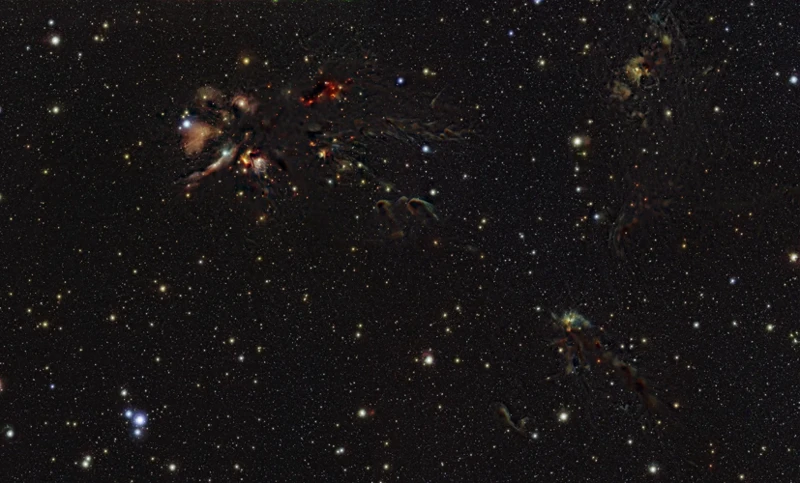
Exploring the features of the Horsehead Nebula offers a glimpse into the intricate and fascinating aspects of this cosmic wonder. One notable feature of the nebula is the iconic “Dark Horse” shape, which gives it its name. This distinctive silhouette is created by the dense cloud of dust and gas that blocks the light from background stars, resulting in a captivating silhouette against the glowing gas clouds in the background. The Horsehead Nebula is also highly studied in the infrared spectrum, revealing additional details that are not visible in visible light. Infrared observations provide valuable insights into the temperature, composition, and structure of the nebula. These observations have shown that the Horsehead Nebula is composed of primarily molecular hydrogen gas (H2) along with other molecules such as carbon monoxide (CO) and helium (He). Along with these molecules, the nebula contains interstellar dust particles that scatter and absorb light, contributing to the unique characteristics of the Horsehead Nebula. The presence of interstellar dust and gas in the nebula signifies regions where new stars are forming, as these materials play a crucial role in the process of stellar birth. Observing and analyzing these features of the Horsehead Nebula enables astronomers to gain a deeper understanding of star formation, the interstellar medium, and the overall dynamics of our evolving universe.
The Dark Horse
The Dark Horse, the iconic feature of the Horsehead Nebula, is a prominent structure that stands out against the backdrop of stars. This dark silhouette captures the imagination and provokes curiosity about its origin and significance in the cosmic landscape. The Dark Horse owes its distinct shape to the dense clouds of dust and gas that compose the nebula. The dust grains within these clouds absorb visible light, creating the appearance of a dark region amidst the surrounding brightness. It acts as a cosmic cosmic curtain, obscuring the light emitted by the stars behind it. The intricate details and contours of the Dark Horse are revealed in stunning clarity through the use of infrared imaging techniques. Infrared light can penetrate the dust, allowing astronomers to capture images that showcase the internal structure of the nebula. These images reveal intricate details, such as the filaments and tendrils of dust that form the distinct shape of the Dark Horse. Additionally, the study of the Dark Horse provides valuable insights into the physics of interstellar matter and the processes that shape and influence star formation. As astronomers continue to explore the secrets of the Dark Horse and the Horsehead Nebula, they uncover new discoveries that contribute to our understanding of the vast and fascinating universe we inhabit.
Nebulae in Infrared
Nebulae, including the Horsehead Nebula, are not only a sight to behold in visible light but also reveal fascinating details when observed in the infrared spectrum. Infrared light has longer wavelengths and can penetrate the vast clouds of dust that obscure the visible light view of these cosmic structures. By using infrared telescopes and detectors, astronomers gain a deeper understanding of the complex dynamics within nebulae. Infrared observations allow scientists to peer through the dense dust clouds and reveal the hidden treasures within. They unveil the birthplaces of stars and provide insights into the processes of stellar evolution. Infrared imaging of nebulae like the Horsehead Nebula also showcases the intricate interplay of different molecules, such as hydrogen, carbon monoxide, and various organic compounds. These observations enable astronomers to study the composition and temperatures of these molecular clouds and gain a better understanding of the conditions necessary for star formation. In the case of the Horsehead Nebula, infrared observations have helped uncover the presence of young stars embedded within the dark gas and dust. These findings contribute to our knowledge of how stars are born and evolve within the cosmic landscape. Exploring nebulae in the infrared spectrum opens up a new realm of discovery, shedding light on the hidden wonders of the universe and expanding our understanding of the celestial phenomena that surround us.
Interstellar Dust and Gas
Interstellar dust and gas play a crucial role in the formation and existence of the Horsehead Nebula. Within this cosmic cloud, countless tiny dust particles and gas molecules reside, creating a dense and intricate environment. The dust particles consist of various elements like carbon, silicon, and other heavy elements. These particles absorb and scatter the ambient light, resulting in the characteristic dark silhouette of the Horsehead Nebula. The gas present in the nebula primarily consists of hydrogen, which is the most abundant element in the universe. As the gas interacts with radiation from nearby stars, it becomes ionized, leading to the emission of light in specific wavelengths. This phenomenon allows astronomers to study the ionized gas using telescopes equipped with specialized filters. The interplay between interstellar dust and gas is not only crucial for the formation of the Horsehead Nebula but also for the development of new stars within it. The dense pockets of dust and gas act as nurseries for star formation, providing the necessary materials and conditions for gravity to collapse and initiate the birth of stars. Through the intricate dance of interstellar dust and gas, the Horsehead Nebula illuminates our understanding of stellar evolution and the cosmic processes at work in the universe. To learn more about the formation and influence of celestial bodies in our lives, you can explore the concept of unveiling planets in the natal chart or delve into the mythological origins of Ophiuchus in Greek culture along with the fascinating zodiac constellations.
Horsehead Nebula and Scientific Research

Scientific research on the Horsehead Nebula has provided valuable insights into various aspects of astrophysics and the processes that shape our universe. One of the primary focuses of studying this nebula is to understand the intricate process of star formation. By analyzing the dense clouds of gas and dust within the Horsehead Nebula, astronomers can gain a better understanding of how stars form from these materials. The nebula’s dark silhouette against the backdrop of illuminated gas allows researchers to study the effects of radiation and stellar winds on the surrounding interstellar medium.
Additionally, studying the Horsehead Nebula aids in advancing our understanding of the interplay between interstellar dust and gas. The nebula’s dense concentration of hydrogen gas provides an ideal environment for investigating the roles of these components and their influence on the formation and evolution of celestial objects. It also provides a unique opportunity to study the chemistry of the interstellar medium and the processes that give rise to complex molecules.
The Horsehead Nebula serves as a laboratory for unraveling the mysteries of how molecular clouds interact with the intense radiation from nearby stars. This interaction and the resulting shock waves can affect the formation of stars and planetary systems. By studying these processes within the Horsehead Nebula, scientists can gain valuable insights into the conditions necessary for the emergence of habitable environments and the potential for the formation of planets.
The Horsehead Nebula plays a critical role in furthering our knowledge of star formation, interstellar chemistry, and the dynamic processes occurring within the interstellar medium. Through scientific research and observation, astronomers continue to uncover the secrets hidden within this captivating stellar phenomenon. The information gleaned from studying the Horsehead Nebula contributes to our broader understanding of the cosmos and expands our horizons in exploring the wonders of the universe.
Studying Star Formation
Studying star formation is one of the key areas of research in which the Horsehead Nebula plays a crucial role. This dark nebula provides scientists with a unique opportunity to observe the early stages of stellar birth. Within the swirling clouds of gas and dust, gravitational forces begin to shape and compress the material, leading to the formation of protostars. These protostars are in the process of accumulating mass and are surrounded by rotating disks of gas and dust. By studying the Horsehead Nebula, astronomers can gain insights into the physical processes involved in star formation, such as the fragmentation of molecular clouds and the role of magnetic fields in shaping the structure of young stars. Additionally, the proximity of the Horsehead Nebula allows for detailed observations and analysis of these processes. With the help of advanced telescopes and instruments, scientists can study the chemistry and physical properties of the material within the nebula, shedding light on the conditions necessary for the formation of stars and planetary systems. Understanding these processes not only contributes to our knowledge of the universe, but also offers valuable insights into our own origins and the potential for life to exist elsewhere in the cosmos.
Impact on Astrophysics
The impact of the Horsehead Nebula on astrophysics cannot be overstated. Studying this remarkable celestial object has provided invaluable insights into various areas of astrophysical research. One of the key areas of investigation is our understanding of star formation. The Horsehead Nebula offers a unique laboratory for studying the intricate process of how stars are born. By observing the dynamics of the nebula, scientists can analyze the gravitational collapse of dense molecular clouds, the formation of protostars, and the subsequent evolution of these stellar nurseries. This knowledge helps refine our models and theories of star formation, shedding light on the mechanisms that shape the birth of stars throughout the universe. Additionally, the Horsehead Nebula plays a crucial role in our understanding of interstellar dust and the cycle of matter in galaxies. The dust grains within the nebula absorb and scatter light, providing valuable insights into the composition and properties of interstellar matter. By studying the dust’s interaction with radiation and magnetic fields, scientists gain a deeper understanding of the complex processes that drive the formation of stars and planetary systems. The Horsehead Nebula’s impact extends beyond astrophysics and into the realm of public engagement with science. The awe-inspiring beauty of this celestial object has inspired countless individuals, leading to increased interest and support for scientific research. Through stunning photographs, artistic representations, and educational outreach initiatives, the Horsehead Nebula has helped ignite a sense of wonder and curiosity about the mysteries of the universe in people of all ages. Its impact on astrophysics, as well as its ability to captivate and inspire, make the Horsehead Nebula an essential icon in the exploration and understanding of our cosmic surroundings.
Unveiling the Beauty of the Horsehead Nebula
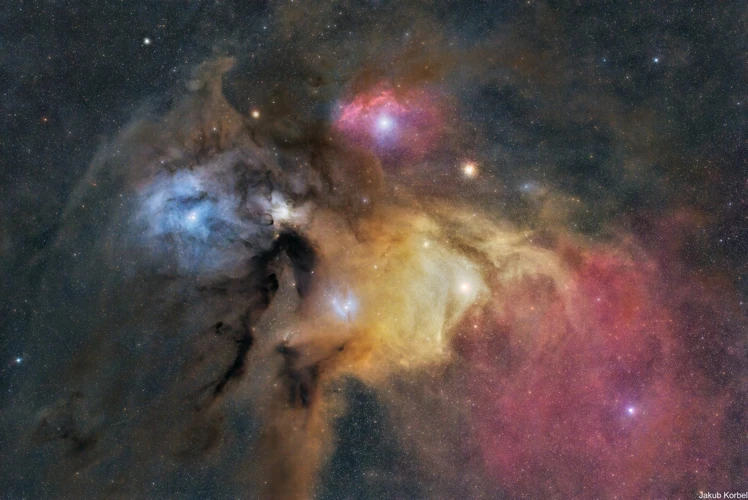
Unveiling the beauty of the Horsehead Nebula allows us to witness its mesmerizing features through various mediums, such as astrophotography and artistic representations. Astrophotography offers a unique opportunity to capture the intricate details of the nebula in stunning imagery. Equipped with specialized cameras and telescopes, astrophotographers can reveal the ethereal wisps of gas and dust, showcasing the contrasting shades of darkness and brightness within the nebula. These captivating images not only allow us to appreciate the cosmic artistry of the Horsehead Nebula but also provide scientists with valuable data to further understand its composition and structure.
Artistic representations of the Horsehead Nebula offer a different perspective, enabling us to visualize the nebula through the eyes of talented artists. Whether through paintings, digital illustrations, or sculptures, artists bring their interpretations to life, capturing the essence and beauty of this celestial wonder. These artistic renditions not only evoke a sense of wonder and awe but also serve as a means to inspire and spark curiosity about the cosmos.
The Horsehead Nebula has become an iconic symbol in popular culture, appearing in movies, books, and even as tattoos. Its striking and mysterious shape has fascinated creative minds for years, adding to its allure and significance in both scientific and artistic realms. By unveiling the beauty of the Horsehead Nebula through astrophotography and artistic representations, we can continue to appreciate its splendor and inspire future explorations of the cosmos.
Astrophotography of the Nebula
Astrophotography of the Horsehead Nebula allows us to capture its stunning beauty and intricate details. Photographing this celestial object requires specialized equipment and techniques to overcome the challenges posed by its faint and elusive nature. To capture the Horsehead Nebula, astrophotographers use powerful telescopes with high-quality optics to gather as much light as possible. They often utilize narrow-band filters that isolate specific wavelengths of light, such as hydrogen-alpha and sulfur filters, to enhance the visibility of the nebula’s glowing gases. These filters help to suppress the overwhelming brightness of nearby stars and focus on the intricate features of the nebula itself. Astrophotographers also employ long exposure times to accumulate enough light and reveal the delicate structures within the nebula. Tracking mounts are used to compensate for Earth’s rotation, allowing for sharp, detailed images. Due to the low light levels and subtle details of the Horsehead Nebula, post-processing techniques are essential to enhance the final image. These techniques involve adjusting brightness, contrast, and color balance to bring out the intricate features of the nebula while maintaining a natural appearance. Astrophotography of the Horsehead Nebula not only showcases its awe-inspiring beauty but also allows scientists and enthusiasts to study its characteristics and gain a deeper understanding of the complex processes occurring within this stellar phenomenon. Captivating images of the Horsehead Nebula serve as a visual testament to the vastness and wonder of the universe and inspire us to continue exploring its mysteries.
Artistic Representations
Artistic representations of the Horsehead Nebula offer a unique and imaginative perspective on this celestial phenomenon. Artists, inspired by the breathtaking beauty and enigmatic nature of the nebula, have sought to capture its essence through various forms of artwork. Paintings, digital illustrations, and sculptures have all been used to bring the Horsehead Nebula to life in vibrant and captivating ways. These artistic interpretations often emphasize the contrasting colors and intricate details of the nebula, highlighting its iconic horse-like shape against the backdrop of interstellar dust and gas. Some artists choose to portray the nebula with a sense of realism, while others take a more abstract approach, using vibrant colors and expressive brushstrokes to create a deeper emotional connection with the viewer. These artistic representations not only showcase the artistic talent and creativity of the artists but also serve as a visual reminder of the wonders of the universe and the awe-inspiring beauty that lies beyond our reach. Whether through traditional mediums or cutting-edge digital techniques, artistic representations of the Horsehead Nebula continue to evoke a sense of wonder and ignite the imagination of those who gaze upon them. They invite us to explore the mysteries of the cosmos and appreciate the boundless beauty that exists in the vast expanse of space.
Conclusion
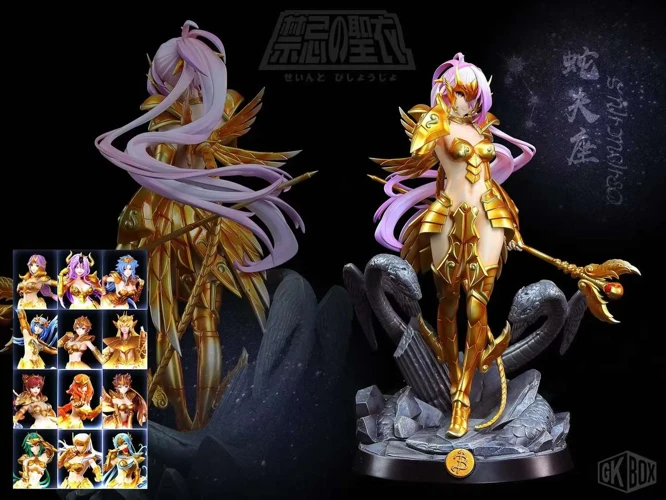
In conclusion, the Horsehead Nebula stands as a stellar phenomenon that sparks wonder and curiosity in the hearts of space enthusiasts. Its enigmatic shape, formation, and significance in scientific research make it a captivating subject of study. Located in the Orion Molecular Cloud Complex, this dark nebula showcases the intricate beauty of interstellar dust and gas, while also shedding light on the process of star formation. Through astrophotography and artistic representations, the breathtaking beauty of the Horsehead Nebula has been unveiled, allowing us to marvel at the wonders of the cosmos. Whether through scientific exploration or artistic appreciation, the Horsehead Nebula reminds us of the vastness and complexity of the universe we inhabit. As we strive to understand and discover more about the mysteries that lie beyond our planet, the Horsehead Nebula will continue to inspire and ignite our sense of awe and wonder.
Frequently Asked Questions

What is a nebula?
A nebula is a vast cloud of gas and dust in outer space. Nebulas can be composed of various elements and compounds, such as hydrogen gas, helium, and other molecules.
How was the Horsehead Nebula formed?
The Horsehead Nebula was formed through a combination of processes. It is believed that the nebula was shaped by stellar winds and radiation from nearby massive stars, which carved out its distinctive horse-like shape.
Why is the Horsehead Nebula so dark?
The Horsehead Nebula appears dark because it contains dense clouds of interstellar dust that block the light from background stars. These dust particles absorb and scatter the starlight, making the nebula appear opaque.
Can the Horsehead Nebula be seen with the naked eye?
No, the Horsehead Nebula cannot be seen with the naked eye. It is located in a region of the sky that is relatively dim, and its faintness requires the use of telescopes or astrophotography techniques to observe.
Is the Horsehead Nebula part of the Zodiac constellations?
No, the Horsehead Nebula is not part of the Zodiac constellations. It is located within the larger constellation of Orion, which is famous for its distinct belt of three bright stars.
How large is the Horsehead Nebula?
The Horsehead Nebula is estimated to be about 3 light-years long and 1.5 light-years wide. This makes it relatively small compared to other nebulae, but its striking shape makes it a popular target for observation.
What is the significance of studying the Horsehead Nebula?
Studying the Horsehead Nebula provides valuable insights into the process of star formation and the dynamics of interstellar materials. By understanding how stars form within dense clouds of gas and dust, scientists can better comprehend the lifecycle of stars and the birth of planetary systems.
How can I locate the Horsehead Nebula in the night sky?
The Horsehead Nebula is located just below the easternmost star of Orion’s Belt, known as Alnitak. It can be challenging to spot due to its faintness, so using a telescope and star charts or stargazing apps can help in locating this elusive nebula.
Can the Horsehead Nebula be photographed?
Yes, the Horsehead Nebula can be photographed using astrophotography techniques. Capturing its intricate features, combined with long exposure times, can reveal the details hidden within the dark dust clouds.
Has the Horsehead Nebula been featured in mythology or art?
No, the Horsehead Nebula has not been specifically featured in mythology or art. However, its captivating appearance and association with the constellation of Orion have inspired artists and writers to depict visions of cosmic beauty and wonder.
References
Frequently Asked Questions

1. How was the Horsehead Nebula discovered?
The Horsehead Nebula was discovered by Williamina Fleming, a Scottish-American astronomer, in 1888. She recognized its distinct shape in photographic plates taken at the Harvard College Observatory.
2. What gives the Horsehead Nebula its unique shape?
The unique shape of the Horsehead Nebula is caused by a dark cloud of dust and gas, which obscures the light from the emission nebula behind it. This creates the illusion of a horse’s head against the backdrop of glowing gas.
3. Can the Horsehead Nebula be seen with the naked eye?
No, the Horsehead Nebula is not visible to the naked eye due to its faintness. It requires a telescope to observe this iconic celestial object.
4. How far away is the Horsehead Nebula?
The Horsehead Nebula is approximately 1,500 light-years away from Earth in the Orion Molecular Cloud Complex, which is a vast region of star formation in the constellation Orion.
5. What is the significance of the Horsehead Nebula in scientific research?
The Horsehead Nebula is significant in scientific research because it offers insights into the processes of star formation and the dynamics of interstellar matter. It serves as a laboratory for understanding the birth and evolution of stars.
6. How can the Horsehead Nebula be located in the night sky?
The Horsehead Nebula is located just below the star Alnitak, which is one of the three bright stars that form Orion’s Belt. Observers can use star maps or astronomy apps to find its precise location within the Orion constellation.
7. What equipment and techniques are required to observe the Horsehead Nebula?
Observing the Horsehead Nebula requires a telescope with a moderately large aperture and a narrowband filter, such as a hydrogen-alpha (H-alpha) filter, to enhance the contrast between the dark nebula and the surrounding gas clouds.
8. How does studying the Horsehead Nebula contribute to our understanding of star formation?
Studying the Horsehead Nebula allows astronomers to investigate the processes involved in the formation of new stars. By studying the interaction between the dark nebula and the adjacent bright emission nebula, scientists can gain insights into the conditions necessary for star birth.
9. Can the Horsehead Nebula be captured in astrophotography?
Yes, the Horsehead Nebula is a popular subject for astrophotographers. Capturing its intricate details requires long exposure times and specialized equipment, but it results in stunning images showcasing the ethereal beauty of this celestial wonder.
10. Are there any artistic representations of the Horsehead Nebula?
Yes, the Horsehead Nebula has captivated the imaginations of artists and has been featured in various artistic works, including paintings, sculptures, and digital art. These representations often emphasize its mysterious and otherworldly qualities.







